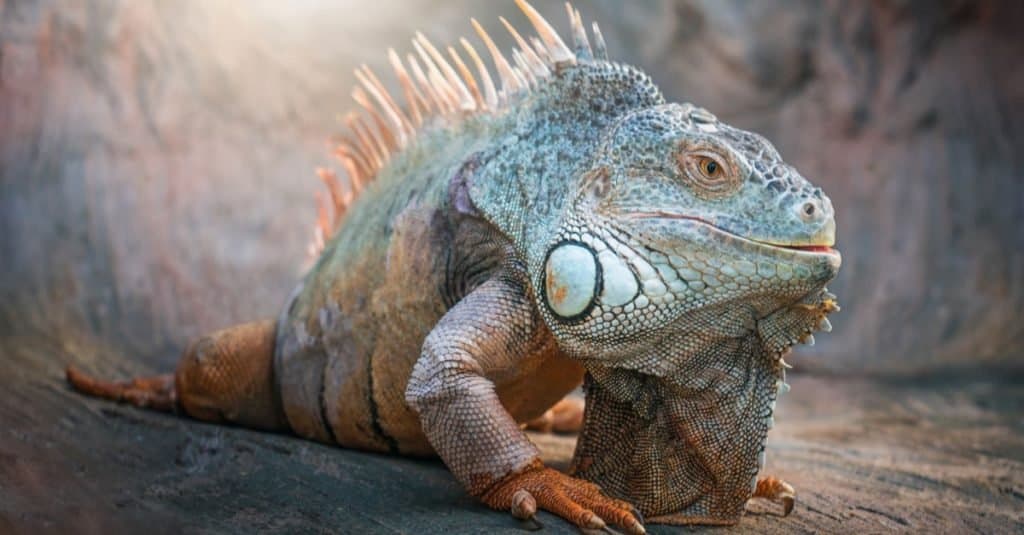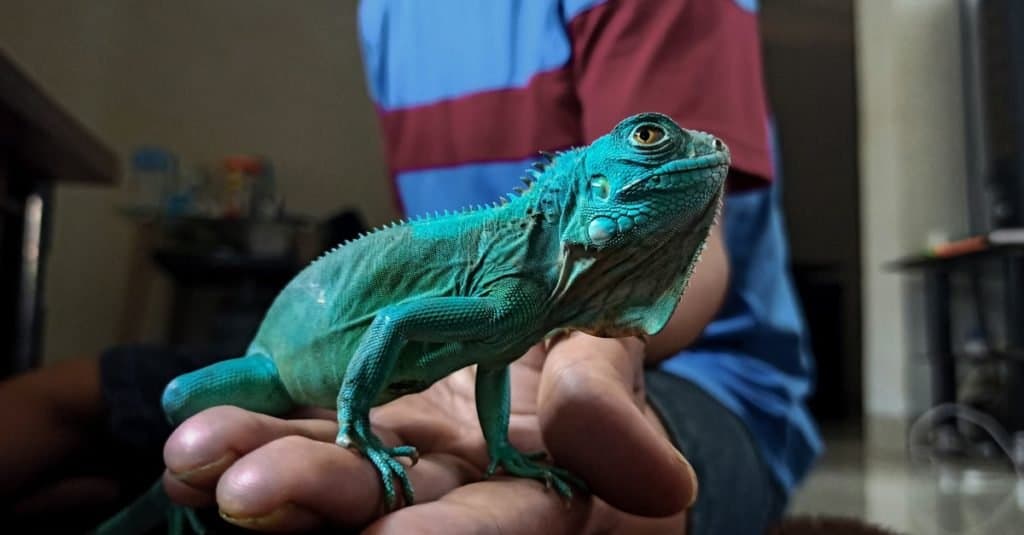Iguanas are some of the most stunning and colorful animals in the world! From the vibrant green iguana to the rosy Galapagos pink land iguana, these lizards stand out amongst thousands of other mostly grey and brown reptiles. But can iguanas change colors like chameleons do, for example? The answer is actually more complex than you’d think!
Keep reading to learn more about iguanas’ shifting shades of green, blue, orange, and more. We’ll also go over the possible reasons why and how an iguana would change color and if you should be worried if your own iguana’s hue happens to look a bit different than before.
Can Iguanas Change Colors?

Iguanas can change in color slightly in response to various environmental changes.
©Holly S Cannon/Shutterstock.com
To be fair, iguanas definitely don’t change their color as drastically as, say, chameleons do. However, they can still change their shade slightly in response to various external stimuli. Some of the main reasons why they occasionally change in color are the following:
- Temperature fluctuations
- Stress
- To appeal to potential mates during breeding season
- Age
- Illness/Injury
- Shedding
As you can see, not all of these reasons are necessarily a cause for alarm. Furthermore, your iguana definitely won’t change from green to purple overnight. They may, however, temporarily shift from light green to dark green or to a slightly different shade of their usual color if they’re cold, shedding, stressed out, or simply showing their dominance to a mate.
Additionally, some iguanas change color slightly as they age. Many young green iguanas, for instance, will change from a vibrant green to a duller greyish-green with patches of orange, red, or even blue upon reaching adulthood. This occurs in plenty of other species in the animal kingdom–even humans! It’s common for our skin tone or hair color to shift slightly over time. Iguanas are actually sort of like us in this regard.
There are a few cases in which a change in color could be worrisome, though. For instance, if an iguana becomes sick or injured, their normally bright color can become dull and grey or brown. But for the majority of iguana species, subtle color shifts are normal. Let’s get into the major reasons why and how iguanas change color in a bit more detail below.
Color Changing Due to Temperature Fluctuations

If an iguana like this Fiji banded iguana becomes cold, it will become darker to absorb more heat.
©Don Mammoser/Shutterstock.com
The most common reason why iguanas shift in color is in response to subtle temperature changes. Because they are ectothermic, or cold-blooded, iguanas will sometimes become darker to take in more heat and sunlight. Green iguanas in particular do this in response to unusually cold winters for survival.
If they are too cold, an iguana’s normally green or blue color may shift to a darker shade than normal. Alternatively, if they become too hot, an iguana might become a bit lighter in color to cool down. This is one of the main ways iguanas and other reptiles adjust their body temperature, or thermoregulate, to adapt to their environment.
Color Changing to Appeal to Mates

Male green iguanas often become more orange during their breeding season to appeal to potential mates.
©Serhii Brovko/Shutterstock.com
Another common reason why iguanas change color is to look more appealing to mates! Once again, we’ll look to the green iguana for a perfect example of this behavior.
While they are normally mostly green or bluish-green in appearance, male iguanas will shift to a more orange or red shade to display their dominance to females as well as other competing males. The color of their spikes, dewlaps, and tails are usually the most affected by this change.
Female iguanas will also change their color in a similar way during their breeding season. However, their color change usually isn’t nearly as pronounced as the males’.
Color Changing Due to Shedding Skin

Iguanas often start to look duller in color a few days before they
shed their skin
.
©Laura Jonker/Shutterstock.com
Iguanas will also often change slightly in color just before they shed their skin. Like most lizards, iguanas do not shed their skin in one large piece like snakes do. Instead, they shed in large patches, usually one after the next, until all of the old skin is removed.
Immediately before they shed, many iguanas of all species will appear to be duller or more gray in color. Their old, loosened skin will start sloughing off in small pieces, then all at once. The new skin is usually more vibrant, giving the iguana a fresh, colorful look–at least until it’s time to shed once more within a few months or so.
Baby iguanas shed much more frequently than adults, or once every few weeks. This is because they are growing rapidly. As a result, their skin must quickly accommodate for their growing size. By comparison, adult iguanas shed roughly once every 4 to 8 weeks.
Color Changing Due to Stress, Injury, or Illness

Even the most vibrant iguanas like this one can become dull in color due to stress, illness, or injury.
©Mohammad Mahfud Muzaqi/Shutterstock.com
One of the more troublesome reasons why an iguana might change in color is as a response to stress, an injury, or illness. In this case, the iguana’s hue won’t become more bright or colorful. Instead, it may become more dull or even grey or yellowish.
Various illnesses can cause iguanas to change in color. For example, respiratory infections, parasite infestations, and even bacterial skin infections can all cause an iguana to look darker and duller than usual. This is one of the most obvious signs to look for if you’re trying to determine if your iguana has developed a health issue.
Additionally, stress and injuries can cause an iguana’s color to look less healthy and vibrant. Burns or lacerations can also cause the surrounding skin to look red or pink. Stressors like changes to their environment or fear due to predators or perceived threats can also cause unhealthy color shifts.
In general, if your pet iguana looks duller than usual and it isn’t because of one of the normal reasons listed above, a health problem may be to blame. If the iguana displays additional symptoms like lethargy or loss of appetite, see a vet as soon as possible.
Do Iguanas Change Color to Camouflage?

Even though iguanas change colors for various reasons, they don’t do it to camouflage themselves.
©npavlov/Shutterstock.com
Iguanas don’t change color to camouflage themselves in the same way chameleons do. While they can slightly change their shade occasionally, they don’t do so to blend in better with their environment. Iguanas can’t change their color at will. Instead, their color changes are the result of environmental changes or health issues.
This is because chameleons’ skin is different from that of iguanas. Chameleons have multiple layers of skin made up of an array of colorful skin cells. These skin cells can change color by rapidly contracting and expanding to match their surroundings.
Iguanas, on the other hand, simply can’t change their individual skin cells in this way. They haven’t evolved to do so and use other adaptations to survive in their specific habitats. Rather than changing color in self-defense, an iguana will use their tail to smack predators or simply bite them before running to safety.
The photo featured at the top of this post is © Holly S Cannon/Shutterstock.com
Thank you for reading! Have some feedback for us? Contact the AZ Animals editorial team.






